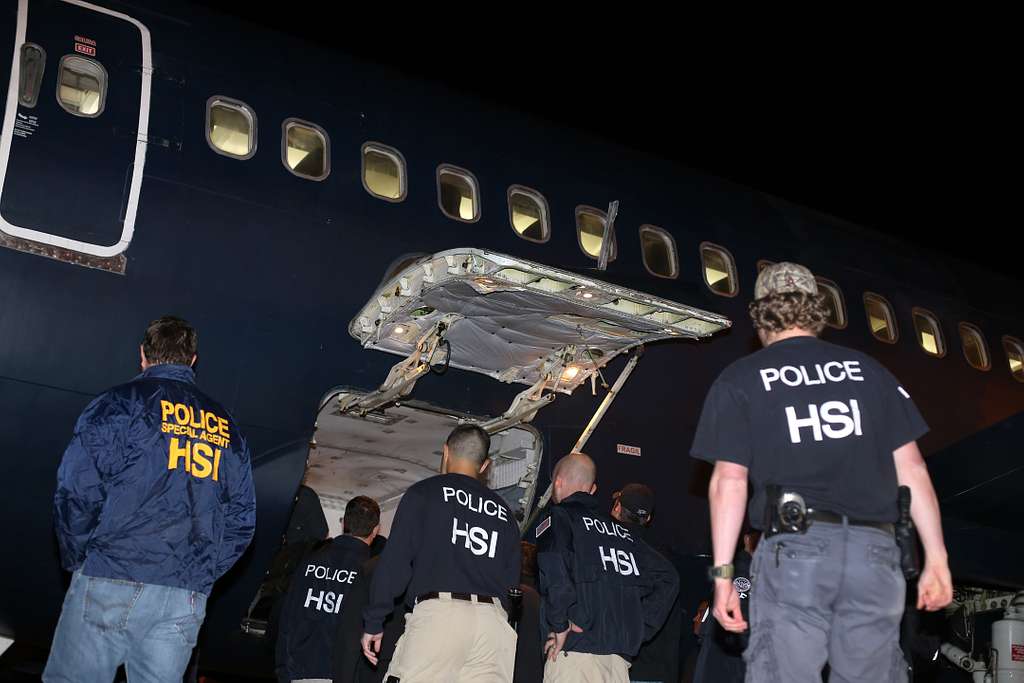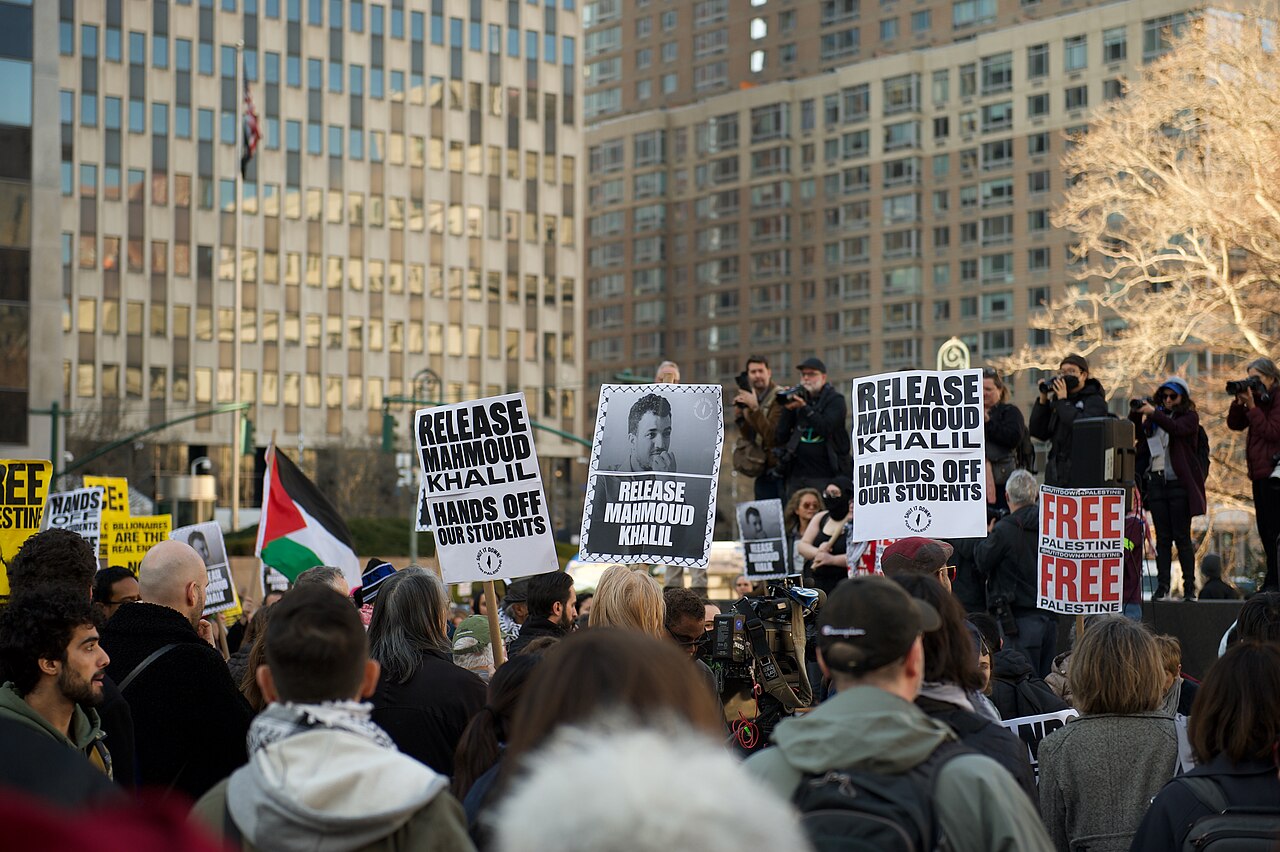What’s Up With the Terror Indictment Against Alleged Antifa Members?
.jpg?sfvrsn=d45482bc_5)
Published by The Lawfare Institute
in Cooperation With

“For the first time ever,” FBI Director Kash Patel announced on Oct. 16, “the FBI has arrested anarchist violent extremists and charged these Antifa-aligned individuals with material support to terrorism.”
Is this a big deal?
No and yes. The arrests were months-old, the new terrorism charge is based on no new facts, and the description “Antifa-aligned” is mere branding. But the indictment may augur worse to come in the administration’s efforts to pursue its ideological enemies.
The arrestees allegedly participated in a July 4 attack on an Immigration and Customs Enforcement (ICE) detention center in Alvarado, Texas. According to a criminal complaint, a local police officer was shot in the neck and 20-30 rounds were fired at Department of Homeland Security correctional officers guarding the facility. The defendants allegedly wore body armor, set off fireworks, spraypainted Department of Homeland Security vehicles with the phrases “Ice pig” and “Fuck you pigs,” and left behind flyers stating “FIGHT ICE TERROR WITH CLASS WAR!” and “FREE ALL POLITICAL PRISONERS.”
By July 16, the Justice Department charged 14 people. Most defendants were charged with aiding and abetting (a) the attempted murder of federal officers during or on account of the performance of official duties and (b) the discharge of a firearm during and in relation to a crime of violence. The department charged one defendant with concealing a document, and two as accessories after the fact. Neither the lengthy factual recitations in the criminal complaints nor the multiple Justice Department press releases in July mentioned Antifa or terrorism—even though state authorities at the time charged the defendants with state-law terrorism offenses.
The October indictment that Patel highlighted added a charge—for only two of the 14 defendants—under 18 U.S.C. § 2339A, which is titled “Providing material support to terrorists.” Section 2339A is the older yet lesser known material support statute; the other, 18 U.S.C. § 2339B, is titled “Providing material support or resources to designated foreign terrorist organizations.” In short, 2339A covers material support for specific acts, whereas 2339B covers material support for specific foreign groups.
Section 2339A was enacted as part of the sprawling Violent Crime Control and Law Enforcement Act of 1994. As amended, the statute authorizes up to 15 years in prison, or a life sentence if death results, for anyone who “provides material support or resources,” while “knowing or intending that they are to be used in preparation for, or in carrying out” any of 57 predicate crimes (including attempting to murder a federal officer) that generally could be described as terroristic in nature.
What happened between July and October to prompt such a charge? On Sept. 10, Charlie Kirk was murdered. In the days after the shooting, administration officials vowed to crack down on what they insisted was rampant leftist violence. On Sept. 17, Trump announced on Truth Social that he would name Antifa as a terrorist organization:
I am pleased to inform our many U.S.A. Patriots that I am designating ANTIFA, A SICK, DANGEROUS, RADICAL LEFT DISASTER, AS A MAJOR TERRORIST ORGANIZATION. I will also be strongly recommending that those funding ANTIFA be thoroughly investigated in accordance with the highest legal standards and practices. Thank you for your attention to this matter!
This appears to have been the first time in his second term that Trump mentioned Antifa either on Truth Social or on X. But it was a return to an old theme. Trump pledged to designate Antifa as a terrorist organization in May 2020 in response to rioting following the death of George Floyd, after teasing the possibility at least twice in the summer of 2019. He didn’t follow through except to issue a presidential memorandum on Jan. 5, 2021, instructing the secretary of state to assess whether Antifa should be designated as a terrorist organization under immigration law, which would have rendered its members inadmissible to the U.S. (Six days later, he would falsely insist to House Minority Leader Kevin McCarthy that Antifa perpetrated the Jan. 6, 2021, attack on the U.S. Capitol.)
This time, however, Trump acted much more quickly—but to questionable effect. On Sept. 22, Trump issued an executive order titled “Designating Antifa as a Domestic Terrorism Organization.” As Thomas Brzozowski, a former counsel for domestic terrorism at the Department of Justice, has explained for Lawfare, this is not a thing. First, while 18 U.S.C. § 2331(5) defines the term “domestic terrorism,” no law provides for designation of a domestic terrorism organization. Trump putting the phrase in quotes does not make it so any more than Michael Scott in “The Office” yelling “I declare bankruptcy!” alleviated his financial woes.
Second, as then-FBI Director Christopher Wray put it in 2020, Antifa is “not a group or an organization” but rather “a movement or an ideology.” As Brzozowski noted in his piece, “Designating Antifa as a ‘domestic terrorist organization’ is equivalent to designating fascism or communism: It is a political statement, not a legally operative act.” Tellingly, the executive order cited no statutes or other legal authority: It was basically a press release. The sparse operative portion directed the government to pursue Antifa to the hilt—with reference to “material support” for “terrorist actions”:
All relevant executive departments and agencies shall utilize all applicable authorities to investigate, disrupt, and dismantle any and all illegal operations—especially those involving terrorist actions—conducted by Antifa or any person claiming to act on behalf of Antifa, or for which Antifa or any person claiming to act on behalf of Antifa provided material support, including necessary investigatory and prosecutorial actions against those who fund such operations.
Three days later, Trump issued National Security Presidential Memorandum/NSPM-7, titled “Countering Domestic Terrorism and Organized Political Violence.” Among other things, NSPM-7 attempted to make “domestic terrorism organization” happen by providing that “the Attorney General may recommend that any group or entity whose members are engaged in activities meeting the definition of ‘domestic terrorism’ in 18 U.S.C. 2331(5) merits designation as a ‘domestic terrorist organization.’”
NSPM-7 defined domestic terrorism with startling breadth—far beyond 2331(5)—by instructing the attorney general to “issue specific guidance that ensures domestic terrorism priorities include politically motivated terrorist acts such as organized doxing campaigns, swatting, rioting, looting, trespass, assault, destruction of property, threats of violence, and civil disorder.” The memorandum instructed investigators to prioritize a narrower list of 13 crimes, including 2339A and 2339B. And as several law firms noted in alerts to their clients, it sharpened focus on nonprofit organizations in new and concerning ways.
Despite neutral operative language, a lengthy introduction made clear that NSPM-7 targeted the left. It described Kirk’s assassination, attempts against Trump and Justice Brett Kavanaugh, and anti-ICE attacks as all of a piece:
There are common recurrent motivations and indicia uniting this pattern of violent and terroristic activities under the umbrella of self-described “anti-fascism.” These movements portray foundational American principles (e.g., support for law enforcement and border control) as “fascist” to justify and encourage acts of violent revolution. This “anti-fascist” lie has become the organizing rallying cry used by domestic terrorists to wage a violent assault against democratic institutions, constitutional rights, and fundamental American liberties. Common threads animating this violent conduct include anti-Americanism, anti-capitalism, and anti-Christianity; support for the overthrow of the United States Government; extremism on migration, race, and gender; and hostility towards those who hold traditional American views on family, religion, and morality.
At a White House event where Trump signed NSPM-7, Deputy Chief of Staff Stephen Miller described the moment as “the first time in American history that there is an all of government effort to dismantle left-wing terrorism, to dismantle Antifa, to dismantle the organizations that have been carrying out these acts of political violence and terrorism.” Miller claimed that an “organized campaign of radical left terrorism” rests on “a [sic] entire system of feeder organizations that provide money, resources, weapons.” Now, he proclaimed, “Kash [Patel] and Pam [Bondi] are going to have the tools they need, working with Scott [Bessent], to take these organizations apart piece by piece.”
On Sept. 26, the Department of Homeland Security posted a press release titled “DHS is Fighting Back Against Antifa Violence,” which included the Alvarado attack in a “non-exhaustive list of the arrests DHS has made to keep America safe from Antifa-aligned domestic extremism.” The list also included the controversial arrest of Rep. LaMonica McIver (D-N.J.) for allegedly assaulting ICE agents outside a Newark immigration detention center. (After McIver’s lawyer notified the court of the press release, the Department of Homeland Security removed it entirely.) Antifa was suddenly everywhere: Transportation Secretary Sean Duffy even claimed the upcoming “No Kings” rallies would be “part of Antifa.”
On Oct. 8, the White House convened an “Antifa Roundtable,” at which Trump discussed Antifa with top aides and an array of right-wing social media journalists. In his opening remarks, Trump called out the July 4 attack as the work of “approximately a dozen Antifa-aligned militants.” Department of Homeland Security Secretary Kristi Noem warned that Antifa was “just as sophisticated as MS-13, as TDA [Tren de Aragua], as Isis, as Hezbollah, as Hamas, as all of them, they are just as dangerous.”
The Antifa indictment was handed up one week later. The “Antifa” part of it, however, is quite slim. It refers to the attackers as “a North Texas Antifa Cell (Antifa Cell) of at least eleven operatives” and describes Antifa as follows:
Antifa is a militant enterprise made up of networks of individuals and small groups primarily ascribing to a revolutionary anarchist or autonomous Marxist ideology, which explicitly calls for the overthrow of the United States Government, law enforcement authorities, and the system of law. Antifa adherents have espoused insurrection and advocated violence to affect the policy and conduct of the U.S. government by intimidation and coercion. Beginning in 2025, Antifa adherents have increasingly targeted agents and facilities related to DHS’s Immigration and Customs Enforcement (I.C.E.) in opposition to I.C.E.’s deportation actions and the U.S. government’s policy on the removal of illegal aliens.
Notably, the first two sentences borrow heavily from the first section of the Sept. 22 executive order (shared language in bold):
Antifa is a militarist, anarchist enterprise that explicitly calls for the overthrow of the United States Government, law enforcement authorities, and our system of law. ... This organized effort designed to achieve policy objectives by coercion and intimidation is domestic terrorism.
That’s the entire discussion of Antifa in the indictment. Of course, an indictment need not specify everything that prosecutors know, and it’s possible that they have identified some links between the defendants and a broader left-wing movement. But the notion of Antifa as an “enterprise” does not comport with experts’ understanding of the movement.
The new terrorism charge seems equally stapled-on. It relies on no new facts. To the extent the defendants are guilty of aiding and abetting the attempted murder of a federal official per 18 U.S.C. §§ 1114 and 2, they are a fortiori guilty of 2339A, whose scope includes anyone who “provides material support or resources ... knowing or intending that they are to be used in preparation for, or in carrying out, a violation of ... 1114[.]” The 2339A charge here is redundant—and possibly inspired by the inclusion of 2339A in NSPM-7. But it gives the administration a nice headline.
As does the mention of Antifa, even though (beyond the fact that it’s not a real entity) its inclusion here is gratuitous. Section 2339A does not depend on the identification of a specific terrorist group. Rather, it covers the provision of support for specified acts, without regard to who the perpetrator might be.
Yet when people hear “material support,” many think “terrorist group.” That’s due to 2339A’s younger, better-known sibling, 18 U.S.C. § 2339B—the most common charge, and basis for conviction, in prosecutions for international terrorism. Two years after enacting 2339A, Congress passed the Antiterrorism and Effective Death Penalty Act of 1996, which included 2339B. As amended, 2339B authorizes up to 20 years in prison, or life if death results, for anyone who “knowingly provides material support or resources to a foreign terrorist organization.” Section 2339B defines “material support or resources” in the same way as 2339A. A “foreign terrorist organization” is defined as one designated by the secretary of state pursuant to a provision in the Immigration and Nationality Act.
Key to 2339B is that any donation to a foreign terrorist organization, even for purportedly innocent activities, is a crime. As then-Solicitor General Elena Kagan summarized the statute: “Hezbollah builds bombs. Hezbollah also builds homes. What Congress decided was when you help Hezbollah build homes, you are also helping Hezbollah build bombs.”
As noted above, the administration is looking for ways to pursue liberal groups that fund its opponents. A Sept, 22 memorandum to several U.S. attorney’s offices from a top Justice Department official reportedly instructed prosecutors to pursue investigations against George Soros’s Open Society Foundations—and mentioned, as a possible charge, material support for terrorism. To do so under 2339A, as discussed above, would require proof that, at a minimum, the defendant knew the support would be used for criminal acts. By contrast, to do so under 2339B would require no such proof: only that the defendant knew the aid was going to a foreign terrorist organization.
What if the Trump administration could categorize its enemies that way?
Incredibly, this might be coming. Near the end of the Oct. 8 Antifa roundtable, a reporter for a conservative news site asked whether Antifa should be classified as a foreign terrorist organization. As far-right activist Jack Posobiec claimed that “they have foreign links all across western Europe,” and Stephen Miller asserted “extensive foreign ties,” Trump said he “would be glad to do it” and “Marco [Rubio] will take care of it.” (Brzozowski recently analyzed possible collateral consequences of such a designation beyond potential criminal liability.)
Kirk’s violent death appears to have flipped a switch for this administration, giving it new impetus to pursue its ideological enemies in creative ways. The Antifa indictment is, itself, the smallest of beans. But danger may lurk ahead.





